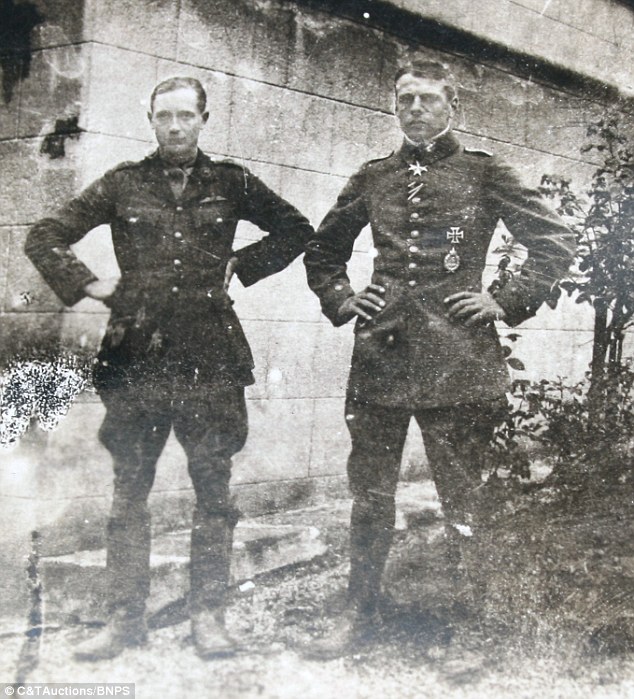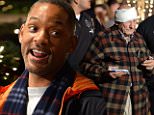Amazing photo shows gallant German First World War ace and the British fighter pilot he shot down... and then shook his hand and made him a coffee
- Oswald Boelcke shot down Robert Wilson in Thiepval, France, in 1916
- Instead of sending Englishman to be interrogated he took him to his mess
- He got Capt Wilson of the 32 Squadron Royal Flying Corps a coffee and gave him a tour of his aerodrome
- Boelcke is regarded as the father of the German fighter air force and trained the Red Baron, Manfred von Richthofen
They were supposed to be the deadliest of enemies, fighting on opposing sides during the darkest days of the First World War.
But this remarkable photograph shows a chivalrous German flying ace posing next to the British fighter pilot he had just shot down in the skies above the battlefields of the Somme.
And in a further display of unexpected gallantry, Oswald Boelcke - who is regarded as the father of the German Luftwaffe - then invited British rival Robert Wilson for a cup of coffee.

Oswald Boelcke, (right) who is regarded as the father of the German fighter air force, shot down Robert Wilson (left), of the 32 Squadron Royal Flying Corps, before inviting him to join him for coffee
The black and white photograph highlights the remarkable chivalry that existed between the rival air forces in the First World War, and has emerged 100 years after it was taken in 1916.
Captain Wilson, of the 32 Squadron Royal Flying Corps, had been flying over northern France when he was shot down by Boelcke and forced to crash land his biplane behind enemy lines.
Leaping from the burning plane, he had to beat out the flames on his arms and legs before he was tracked down by Boelcke - the legendary aviator who trained the Red Baron, Manfred von Richthofen.
But rather than hold Capt Wilson at gunpoint and send him away for interrogation, Boelcke shook his hand, took him for coffee in the mess and gave him a tour of his aerodrome.

The black and white picture was found in an album of 105 First World War photographs found in an old album amassed by an unknown German airman, which also includes this shot of a tank

An Imperial German aircraft with the pilot and gunner sitting inside. Capt Boelcke (not pictured) was legendary on both sides of No Man's Land for his chivalry
The German later wrote: 'When he went down, his machine was wobbling badly, but that, as he told me afterwards was not his fault, because I had shot his elevator to pieces.
'It landed near Thiepval - it was burning when the pilot jumped out, and he beat his arms and legs about because he was on fire too.
'I fetched the Englishman I had forced to land - a certain Captain Wilson - from the prisoners clearing depot, took him to coffee in the mess and showed him our aerodrome, whereby I had a very interesting conversation with him.'
Capt Wilson was shot down in September 1916 and was Capt Boelcke's 20th 'kill' of the war.
By that stage the German's legendary status had already been secured on both sides of No Man's Land.
Seven months earlier he had risked his life to fly over British lines and drop a letter informing them one of their missing airmen, Lieutenant Geoffrey Formilli, was alive and safe after he had personally visited him in hospital.
After being released at the end of the war, Capt Wilson described his encounter with Boelcke as 'the greatest memory of my life, even though it turned out badly for me.'

A destroyed German plane, as seen in the photo album, which is on sale for £1,000
The photo that has now emerged 100 years later was one of the last taken of Capt Boelcke as he was killed in action a month later after his plane had a mid-air collision with another German aircraft.
Although his crash-landing was survivable, he died from head injuries on impact because he never wore a helmet.
The picture is one of 105 First World War photographs found in an old album amassed by an unknown German airman.
Other images depict German aircraft, battle damage and aerial photos of Verdun, the scene of one of the biggest battles of the conflict that took place between February to December 1916.
Matthew Tredwin, of C&T Auctions of Ashford, Kent, said: 'Flying in the First World War was almost like a gentleman's club no matter which side you were on.
'An unspoken camaraderie existed between Allied and German pilots.
'A lot of these men were celebrities of their time because what they did had a certain romance about it, even though it was deadly.
'It is unlikely that the original owner of the album actually took this photograph. It is more likely this picture was mass-produced for fellow airmen and fans to keep.
'It is a lovely album and has come from a British-based collector. He bought it some years ago from a dealer on the German/Belgian border.'
Boelcke was by far the most important and famous of the German aces of the early years of WWI, and is credited with formalising the fundamental aerial manoeuvres and rules of combat.
The photo album is being sold on March 30 with a pre-sale estimate of £1,000.
-
 Man shot dead after holding girlfriend hostage in California
Man shot dead after holding girlfriend hostage in California
-
 Shocking moment toddler cries over 'dead' woman amongst...
Shocking moment toddler cries over 'dead' woman amongst...
-
 Mishal Hussain challenges Suu Kyi on muslim 'ethnic...
Mishal Hussain challenges Suu Kyi on muslim 'ethnic...
-
 Katt Williams gets in brawl with teenager after sucker-punch
Katt Williams gets in brawl with teenager after sucker-punch
-
 Bomb disposal robot approaches body after suspect shooting
Bomb disposal robot approaches body after suspect shooting
-
 Obama shows off his moves with tango dancer in Argentina
Obama shows off his moves with tango dancer in Argentina
-
 Woman steps on Brussels memorial tributes to cover Israeli...
Woman steps on Brussels memorial tributes to cover Israeli...
-
 Teacher knocks down special needs student, then resigns
Teacher knocks down special needs student, then resigns
-
 Ben Carson defends endorsing Donald Trump on 'The View'
Ben Carson defends endorsing Donald Trump on 'The View'
-
 Street fight leaves one man dead, over 9 charged w/ murder
Street fight leaves one man dead, over 9 charged w/ murder
-
 Suspect neutralised in anti-terrorist operation in...
Suspect neutralised in anti-terrorist operation in...
-
 Teen who took down Katt Williams after sucker-punch speaks
Teen who took down Katt Williams after sucker-punch speaks
-
 Belgium turns on immigrants after Brussels bloodbath as...
Belgium turns on immigrants after Brussels bloodbath as...
-
 'He was the kindest and funniest of geniuses': Larry Sanders...
'He was the kindest and funniest of geniuses': Larry Sanders...
-
 EXCLUSIVE - Inside the den of terror: Extraordinary first...
EXCLUSIVE - Inside the den of terror: Extraordinary first...
-
 Armed police shoot man 'carrying a bomb in a rucksack after...
Armed police shoot man 'carrying a bomb in a rucksack after...
-
 Donald Trump DENIES he is behind National Enquirer claim...
Donald Trump DENIES he is behind National Enquirer claim...
-
 Dramatic moment SWAT team rescue woman, 28, drag her to...
Dramatic moment SWAT team rescue woman, 28, drag her to...
-
 PIERS MORGAN: Twinkle-toes Obama might be a demon at the...
PIERS MORGAN: Twinkle-toes Obama might be a demon at the...
-
 Why IS William still fascinated with his old flame Jecca?...
Why IS William still fascinated with his old flame Jecca?...
-
 Moment NYPD cop shoots a dog DEAD at pointblank range with...
Moment NYPD cop shoots a dog DEAD at pointblank range with...
-
 Moment Burma heroine lost her cool with Today show's Mishal:...
Moment Burma heroine lost her cool with Today show's Mishal:...
-
 Obama dances while Brussels burns: President and Michelle...
Obama dances while Brussels burns: President and Michelle...
-
 Students freak out because someone chalked trump slogans on...
Students freak out because someone chalked trump slogans on...

























































































































































































![, In tonight¿s episode (Thursday 24th March, 10pm, Channel 4), Alan will be joined by all four of The Voice coaches who will be talking about this year¿s competition - Paloma Faith, Boy George, WILL.I.AM and Ricky Wilson.\nThe cast of Channel 4¿s Fresh Meat, Jack Whitehall, Charlotte Ritchie, Joe Thomas and Greg McHugh will be chatting about the final series of the show. \nMusic this week is from Years and Years performing their new single Desire live in the studio, as well as speaking to Alan. \nPlease find pictures attached, and quotes below from The Voice and Fresh Meat.\nCheers,\nHannah\nAlan Carr Chatty Man ¿ Series 16, Episode 4 (TX Thursday 24th March, 10pm Channel 4)\n\nThe Voice (Will.i.am, Boy George, Paloma Faith and Ricky Wilson)\n \nPaloma and George on being X Factor judges \n \nAC: Last time you were on here, you [Paloma] were lined up to be on X Factor? \n \nPF: Was I? \n \nAC: Yeah! We were talking about it? \n \nPF: What did I say? I don¿t remember us discussing this](http://web.archive.org/web/20160325231900im_/http://i.dailymail.co.uk/i/pix/2016/03/25/01/3289F2B500000578-0-image-m-90_1458868802850.jpg)













































































































































































